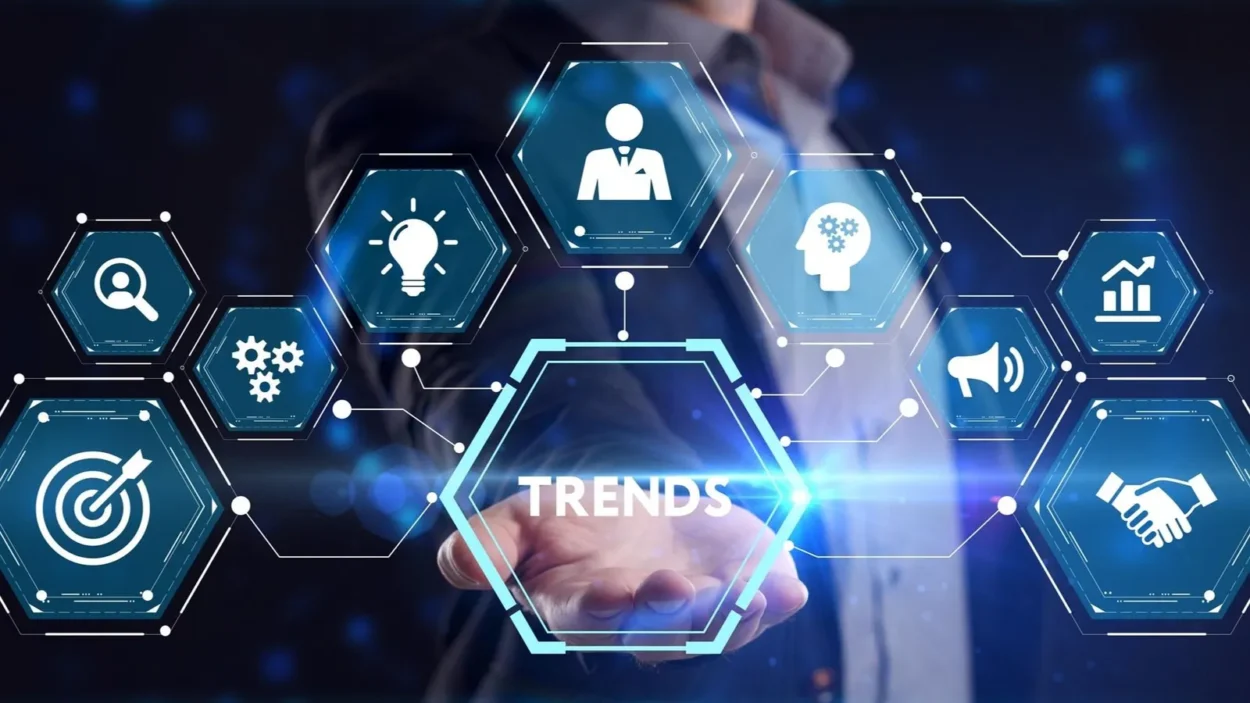Technology has become an inseparable part of our daily lives, constantly shaping how we work, communicate, shop, travel, and even take care of our health. Every year, new innovations and digital solutions transform ordinary routines into smarter, faster, and more efficient experiences. These aren’t just big breakthroughs for industries—they’re small but powerful changes that directly affect the way people live their everyday lives.
In this article, we’ll explore 20 of the latest tech trends that are not only innovative but also deeply influential in making modern living more convenient, connected, and sustainable.
1. Artificial Intelligence (AI) in Daily Applications
Artificial Intelligence is no longer just for advanced research or big companies. Today, it’s part of everyday apps and devices—whether it’s your phone’s smart assistant, personalized shopping recommendations, or even grammar-checking tools. AI helps people save time by automating repetitive tasks, offering smarter search results, and predicting what you might need next.
From chatbots in customer service to AI-driven home cleaning robots, this technology is quietly becoming your daily assistant. AI’s growing presence shows how advanced computing is being woven seamlessly into regular life.
2. The Rise of Smart Home Devices
Smart home technology has made everyday living far more convenient. Devices like voice-controlled assistants, smart thermostats, and security systems let you control your home environment with a single command or even remotely from your phone.
Whether it’s turning off lights, adjusting room temperature, or checking your door camera while at work, smart homes are bringing comfort and safety together. For busy individuals, these devices save energy, time, and stress, proving how connected living is shaping modern households.
3. Wearable Health and Fitness Tech
Smartwatches and fitness trackers have become essential tools for millions of people worldwide. They don’t just track steps anymore—they monitor heart rate, sleep cycles, stress levels, and even blood oxygen.
By providing real-time health data, wearables encourage people to adopt healthier lifestyles. They also help detect early warning signs, reminding you to stay active, drink water, or get proper rest. This tech trend is reshaping how individuals take control of their personal wellness.
4. The Expansion of 5G Connectivity
The rollout of 5G networks has dramatically improved internet speed and reliability. For everyday life, this means smoother video calls, faster downloads, and more stable streaming—even in crowded areas.
Beyond entertainment, 5G allows for smarter cities, better healthcare services through telemedicine, and enhanced education with high-quality virtual learning. It’s making instant connectivity a standard expectation rather than a luxury.
5. Mobile Payment Systems
Cash is quickly becoming less common as mobile wallets and contactless payments rise in popularity. Apps like Apple Pay, Google Pay, and local fintech solutions make paying for groceries, transport, or online shopping seamless and secure.
This trend has been especially significant in reducing the need for physical cash handling, offering safer and more hygienic solutions. For everyday life, it means faster checkouts, reduced dependency on wallets, and greater convenience in financial transactions.
6. Telemedicine and Virtual Healthcare
Healthcare has transformed with the growth of telemedicine. Instead of waiting hours at clinics, people can now consult doctors online, get prescriptions digitally, and monitor health conditions using connected devices.
This trend makes healthcare more accessible, especially for people in remote areas or those with busy schedules. With virtual consultations becoming normal, medical support is now available from the comfort of home.
7. Remote Work and Collaboration Tools
The shift toward remote work has led to massive adoption of collaboration platforms like Zoom, Microsoft Teams, and Slack. These tools allow teams to work effectively from anywhere in the world.
For daily life, this trend gives people more flexibility in managing work-life balance, reduces commuting stress, and opens opportunities to work globally without relocation. Remote collaboration is not just a temporary shift—it’s becoming part of modern career culture.
8. Streaming and On-Demand Entertainment
Gone are the days of fixed TV schedules. Streaming platforms like Netflix, Disney+, and YouTube provide unlimited access to entertainment whenever and wherever you want.
This has reshaped how families, friends, and individuals spend their free time. With personalized recommendations powered by AI, people discover new content that matches their interests, making entertainment more tailored than ever before.
9. E-Learning and Online Education Platforms
Education has gone digital. Platforms like Coursera, Udemy, and Khan Academy are making high-quality courses available to anyone with internet access. Students and professionals alike are turning to online education to upskill.
This trend improves accessibility, allowing people to learn at their own pace and from global experts. For everyday life, it means greater opportunities for growth, career advancement, and personal enrichment from home.
10. Electric Vehicles (EVs)
Electric cars are no longer futuristic—they’re becoming part of daily commuting. With companies like Tesla, BYD, and others making EVs more affordable, many people are switching to cleaner, greener transport.
For daily life, EVs reduce fuel costs, require less maintenance, and help lower carbon footprints. Charging stations are expanding globally, making EVs more practical than ever.
11. Online Grocery and Food Delivery Apps
Ordering groceries or meals through apps like Instacart, Uber Eats, or local services has become second nature for millions. This trend saves time, provides convenience, and expands food options without leaving home.
From busy professionals to families, online delivery has integrated into everyday routines. For many, it’s a lifestyle upgrade that combines comfort with efficiency.
12. Virtual and Augmented Reality (VR & AR)
VR and AR are changing how people play, learn, and shop. From immersive gaming experiences to trying on clothes virtually before purchase, these technologies are blending digital and physical worlds.
For daily living, AR in smartphones helps with navigation, interior design, and even interactive learning. It’s no longer just for gaming—it’s shaping practical everyday solutions.
13. Cloud Storage and Digital Productivity
Cloud storage tools like Google Drive, Dropbox, and iCloud allow people to access files from anywhere, eliminating the need for USB drives. For both work and personal life, it means important documents, photos, and projects are always safe and available.
This trend supports remote collaboration, protects against data loss, and streamlines daily tasks. Cloud solutions have become the invisible backbone of modern digital life.
14. Personalized Shopping with AI
E-commerce has become smarter with AI-driven personalization. Online stores now recommend products based on browsing history, past purchases, and interests.
This trend makes shopping faster, more enjoyable, and tailored to personal needs. It reduces decision fatigue and helps consumers discover items they genuinely want, making retail experiences more intuitive.
15. Sustainable Tech Solutions
Sustainability has become a driving force in technology. From eco-friendly gadgets to apps that track carbon footprints, modern innovations are encouraging greener lifestyles.
People can now choose energy-efficient appliances, solar-powered devices, and recyclable products. For everyday life, this trend means more environmentally conscious living without sacrificing convenience.
16. Voice Search and Smart Assistants
As voice recognition improves, people are increasingly using voice assistants like Alexa, Siri, and Google Assistant. Instead of typing, they ask questions, control devices, or set reminders with a voice command.
This makes multitasking easier and saves time. For example, you can check the weather, play music, or order groceries while cooking—all hands-free.
17. Cybersecurity Awareness Tools
As technology becomes more embedded in daily life, protecting personal data is crucial. People are now using password managers, two-factor authentication, and antivirus apps to secure information.
Cybersecurity tools have become part of regular routines, ensuring safer online shopping, banking, and communication. This growing awareness highlights how digital security is as important as physical security in today’s world.
18. Smart Fitness Apps and Virtual Coaching
Fitness apps and virtual coaching platforms are making exercise more accessible. With guided workouts, progress tracking, and even AI-driven feedback, people can now stay fit without visiting gyms.
For busy individuals, these tools fit seamlessly into daily routines, offering flexibility and motivation. Fitness technology has redefined how people approach health and wellness.
19. Green Energy in Homes
Solar panels, smart grids, and energy-efficient appliances are trending worldwide. Households are adopting renewable energy solutions to reduce bills and environmental impact.
For everyday life, green tech provides cleaner air, long-term savings, and energy independence. Sustainable living is no longer a luxury—it’s becoming the new standard.
20. The Internet of Things (IoT)
IoT connects everyday objects—from refrigerators to cars—to the internet, making them smarter. For instance, your fridge can remind you to buy milk, or your car can update you on maintenance needs.
This interconnected network of devices streamlines everyday living. It saves time, reduces effort, and ensures smarter decision-making with real-time data.
Final Thoughts
Technology is not just about futuristic inventions—it’s about practical changes that shape everyday life. From the way we shop and work to how we travel, learn, and stay healthy, modern innovations are transforming ordinary routines into smarter, more efficient experiences.
By embracing these trends, individuals can improve productivity, enjoy greater convenience, and live more sustainably. Technology is not slowing down—it’s evolving faster than ever, and its role in daily living will only continue to expand.




Sign up